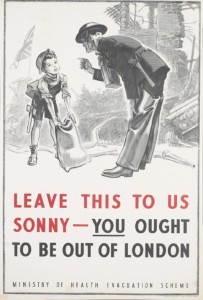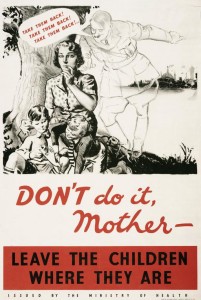Relevant History welcomes back Mary Reed aka Eric Reed, pseudonym for Mary Reed and Eric Mayer, co-authors of the John, Lord Chamberlain, mystery series set in 6th century Byzantium. Murder in Megara, the eleventh entry, was published in October 2015 by Poisoned Pen Press. The Guardian Stones, a World War Two mystery set in rural Shropshire, England, appeared in January 2016 from the same publisher. To learn more about them and their books, visit their web site and blog, and follow them on Twitter (Mary and Eric.)
*****
This past month or two the news has been full of reports of evacuations from wild fires or floods, but they pale by comparison to the voluntary evacuation of about twenty percent of British children on the very eve of World War Two. Other evacuations occurred later, but this was the first event of its kind and the largest mass movement of civilians carried out in the UK.
 Planning for the event had begun in May 1938 as it became increasingly obvious the outbreak of hostilities was inevitable. Hansard, the official record of the proceedings in Parliament, reported work on the task in hand 2 February 1939. During a House of Commons debate on air raid precautions, in response to a question from the MP representing a Tyneside town, the Lord Privy Seal stated plans were then in preparation for evacuating Newcastle-on-Tyne and Gateshead schoolchildren.
Planning for the event had begun in May 1938 as it became increasingly obvious the outbreak of hostilities was inevitable. Hansard, the official record of the proceedings in Parliament, reported work on the task in hand 2 February 1939. During a House of Commons debate on air raid precautions, in response to a question from the MP representing a Tyneside town, the Lord Privy Seal stated plans were then in preparation for evacuating Newcastle-on-Tyne and Gateshead schoolchildren.
Newcastle-on-Tyne being my (Mary) birth city, naturally I was interested how the situation was handled there, and details will serve as an example of arrangements put in hand all over the country.
Dress rehearsals
Staggering logistical problems faced those organising the nation-wide evacuation of children as part of the unfortunately-named Operation Pied Piper.
Just how complex these plans were can be gleaned by perusing “Evacuation of Civilian Population from Newcastle and Gateshead In The Event of Emergency.” The document was sent in mid-August 1939 to local authorities in Newcastle-on-Tyne and Gateshead by the London & North-East Railway, which was to carry out evacuation over the course of two days.
Schoolchildren accompanied by their teachers and helper-volunteers were to leave on the first day, with passengers on the second composed of what were termed special classes, these being predominantly mothers with children too young to attend school. Payment for evacuating trains was agreed between the railway and the Ministry of Transport.
To familiarise all concerned with what they should do and where they should go when the day arrived, a dress rehearsal was held in late August 1939 in the two cities.
The LNER booklet includes a chilling note that “Should hostilities begin before evacuation is completed the pre-arranged plan may require to be modified”. In the event, changes were not necessary but it was a close-run thing. The official order for evacuation to begin was issued in the late morning of 31 August 1939, and the first two days of September saw the removal of children from the two cities to rural areas of Westmoreland, Cumberland, Yorkshire, and Northumberland.
Only just in time: war was declared on 3 September 1939.
Even a glance at the LNER booklet provides a hint of the massive planning and coordination effort between local authority officials, schools, the police, railway personnel, and others needed to get children at risk away from Tyneside.
o District Evacuation Officers were made responsible for arrangements for the evacuation of schools in their specific districts. They were also to serve as liaison between individual railway stations and the schools being evacuated therefrom.
o Coloured armlets would identify the roles of those wearing them. Thus Newcastle-on-Tyne Evacuation Officers would wear blue armlets, and teachers white ones.
o All passengers were to be labeled or ticketed as proof they were permitted to travel on the evacuating trains.
o The railway’s Liaison Officers would have sole charge of entraining and would work with the Evacuation Officers when the official order to evacuate had been issued.
o Medical personnel were to be available at each station in case children become distressed.
o The public and mothers of the children evacuated on the first day were not to be allowed on the platforms during evacuation.
There must have been many tears at parting and in the temporary homes to which evacuees were sent. Their experiences were varied to say the least. Some met nothing but kindness, others were ill-treated, sometimes physically abused. Some who were homesick or unhappy at being sent away from their families absconded in an attempt to rejoin them, though others were reportedly relieved to be living away from their old homes due to bad conditions or neglect there. Indeed, a number of children arrived with less than the minimum of recommended luggage. Not every family could afford to send their children off with spare clothing, a warm coat, or even such basic necessities as a toothbrush and handkerchiefs.
Not all children were sent away
 Many parents kept their children at home because they did not want to be separated from them. Another factor in their decision was the difficulty and expense of the travel needed for them to visit their evacuated children. Some evacuees were brought back when they fell ill or had accidents and older children who had contributed to the family income returned as they were still needed to do so.
Many parents kept their children at home because they did not want to be separated from them. Another factor in their decision was the difficulty and expense of the travel needed for them to visit their evacuated children. Some evacuees were brought back when they fell ill or had accidents and older children who had contributed to the family income returned as they were still needed to do so.
In response to a question put to the Minister of Health on 1 February 1940 concerning how many unaccompanied children had returned to certain cities, the Minister reported a January estimate had noted that of 28,300 children evacuated from Newcastle-on-Tyne, 14,000 were already back in the city. There does not seem to be any comparable figure readily available for Gateshead, from which 10,598 children had been sent away, but in both cities 71 percent of eligible schoolchildren were evacuated.
Birmingham, another major industrial city, sent over 25,000 schoolchildren to safer areas. In The Guardian Stones, published as by Eric Reed, we introduced a handful of trouble-making evacuee children from Birmingham whose behaviour made them not particularly welcomed by the residents of Noddweir, a remote Shropshire village near the Welsh border. The second book in the series is now being written and will take Grace Baxter, one of the main characters in The Guardian Stones, to wartime Newcastle-on-Tyne.
*****
 A big thanks to Eric Reed. They’ll give away an ebook copy of The Guardian Stones to someone who contributes a comment on my blog this week. I’ll choose the winner from among those who comment by Friday at 6 p.m. ET. Delivery is available worldwide.
A big thanks to Eric Reed. They’ll give away an ebook copy of The Guardian Stones to someone who contributes a comment on my blog this week. I’ll choose the winner from among those who comment by Friday at 6 p.m. ET. Delivery is available worldwide.
**********
Did you like what you read? Learn about downloads, discounts, and special offers from Relevant History authors and Suzanne Adair. Subscribe to Suzanne’s free newsletter.

What a fascinating bit of history. I have a friend whose mother lived through WWII in London as a young girl. She was not evacuated and for many years talked about how frightening it was to live through the war.
Thank you for your comment, Margaret.
It amazes me how people in London and other cities who were experiencing night after night of bombing and often with gas and water gone and huge fires still blazing could get up and somehow go to work every day. Talk about grit!
I have a friend who was evacuated from a London suburb to a town in Wales for a while. She was so young that she has little memory of the experience. I think her mother went with her but her father worked for the railroad and was considered essential there.
Appreciate your comment, Carolyn. It must have been a terrible dilemma. The little ones especially would be so afraid to leave their parents to live with strangers. The whole thing is just heart-breaking.
What an incredible behind-the-scenes look at the scale and planning, as well as the emotional toll of this part of the war. England’s toughness in the face of overwhelming odds never ceases to amaze me.
Thanks for your comment, Ruth. I strongly believe the streak of stubborness in the national character also played a large part in coping with war conditions and a good job too!
Wanted to say thanks to Suzanne for running this blog but others got there ahead of me! So thank you Suzanne. Appreciate it.
You’re welcome. The post hits a nerve with all parents.
So very sad that families can’t stay together and yes it happens but has to be so very heartbreaking!
Thanks for your comment, Lynn. The evacuation was a marvellous bit of organisation but the psychological toll on children and parents is said to have been high in some cases, something not often mentioned.
I have of course seen movies and even documentaries about evacuations, but had never realized the scope until Mary’s post! I thought only London kids were relocated.
Thanks for the info, especially the railroad pamphlet contents.
Appreciate your comments, Mari. The booklet was a marvellous find!
I don’t think I was aware of the evacuations until I read the Narnia books (in adulthood). Is it true that some children were evacuated to America?
Thanks for your comment, Sandra. You might be interested in memories of one girl who was indeed evacuated to the US. They appear on an excellent BBC site devoted to memories of the war. She went via Canada, to which a number of children were evacuated.
http://www.bbc.co.uk/history/ww2peopleswar/stories/78/a2094978.shtml
Would love to read this one since I enjoy historical featured stories.
A really interesting article
Thanks for your comment, Joyce. The civilian experience in WW2 is a particular interest of mine so this was a topic tailor made for me!
Very interesting. It makes me wonder about the statistics on how many children became lost throughout this time and the number of children were actually saved because of the evacuation. Well done!
Thanks for your comment, Barbara. I have not see any info on that topic but if I come across any I shall post it back here.
Ana Freud wrote her observations of the behavior of the children who were away from their parents. It makes interesting reading.
Thanks, Warren. Will keep an eye out for the book you mention. I believe there was recently published one relating interviews with children who had not done well when evacuated, but I have not yet seen it.
To someone stuck in the middle of the States, this almost reads like science fiction. I do believe we should all visit the war museums the UK has to give us a better perspective of our world. Thanks for your wonderful historical novels to bring it closer to us. I have the entire Lord C series and look forward to this one.
Grateful for your comment, Nancy. If you get a chance to go to the UK, do not miss the Imperial War Museum in London! And thanks for your kind words about John’s adventures. This book is very different but no spoilers her!
(Reply to Mary Reed’s comment.) I have done all the war museums on my trips to London and am always amazed at how little we complacent USA residents really know about this war. And it is obvious with the subject matter that the new series is nothing like Constantinople. But I like all eras if the books are written well. Yours are.